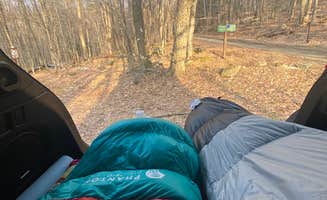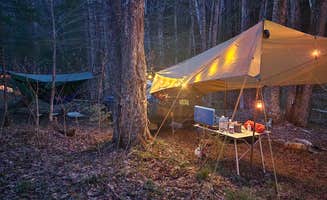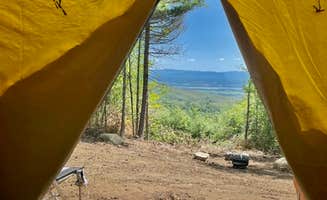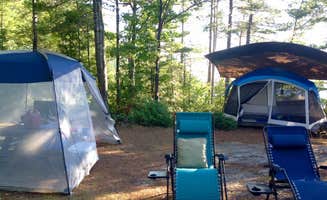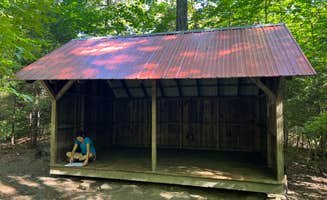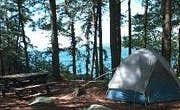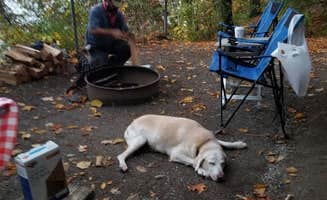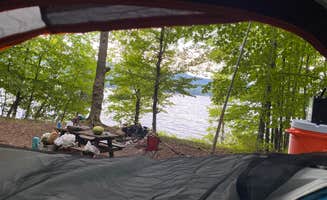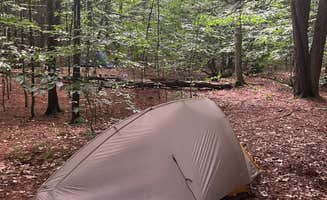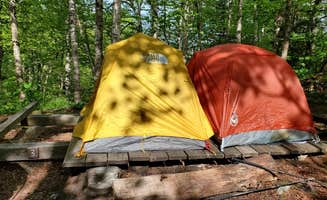Green Mountain National Forest surrounds Brandon, Vermont with numerous dispersed tent camping areas at elevations between 750-1,500 feet. The camping region experiences distinct seasonal changes with summer temperatures averaging 70-85°F and winter lows frequently below freezing. Forest service roads throughout the area provide access to primitive tent sites, though many become completely impassable after significant rainfall or during winter months when snow accumulation exceeds 2-3 feet.
What to do
Swimming in natural holes: Visitors to Michigan Brook can find several swimming spots along the stream. According to one camper, "Drive in about a mile after the parking lot!! Can use car to get in! There's 3 camping spots. 1 before the bridge and 2 after the bridge! The one before the bridge that's right next to the river is the best one!!"
Hiking on Appalachian Trail sections: Tent campers can access trail segments near Stony Brook Backcountry Shelter with moderate difficulty levels. A hiker notes the area has "a swimming hole and consistent water just a bit further down the trail (when heading northbound)." The shelter area includes "a few large tent areas where multiple tents could fit and which looked quite level."
Forest exploration: Several unmarked trails branch from main camping areas with terrain suitable for day hikes. A visitor at Bingo campground mentioned, "Nice area to stay in for access to the National forest. Beautiful stream close by." These informal paths provide opportunities to observe local wildlife including deer, foxes, and various bird species.
What campers like
Riverside locations: Multiple campsites along Patterson Brookside camp offer direct water access. As one camper observed, "Mountain road lingers along the river. There's quite a few sites along the road. Be sure to camp at spots with established fire rings! There is no services of any sorts at this location."
Budget-friendly options: Most dispersed sites in the national forest require no fees. A reviewer of FR25 Dispersed Camping commented on the area's popularity: "All the sites were full when I visited (6 to 8 sites, approximately, but i didn't go down a couple little gravel paths to check each spot as you couldn't turn around easily)."
Privacy between sites: Many locations provide natural separation between camping areas. At Michigan Brook Road Camping, one visitor found "most of the spots to be on the road before the GPS marker. Few nice ones near the creek. I stayed at one on top of a hill—lots of space at mine."
What you should know
Vehicle requirements: Access roads to many sites require appropriate vehicles. At Last Light on Michigan Brook, campers advise: "The very last spot on the right hand side. If you've reached the closed gate you've missed the site!" Road conditions deteriorate significantly during spring thaw and after heavy rainfall.
Limited amenities: Most sites lack facilities entirely. Bring sufficient water for drinking, cooking, and cleaning. One FR25 visitor observed concerning maintenance issues: "There was a NFS sign along FR-25 posted asking people to clean up after themselves (litter and human waste) as there'd been complaints to the extent that they were considering closing the sites if people didn't do better."
Cell service limitations: Communication options vary significantly by location. A camper at Michigan Brook Road noted: "This location does not provide cell phone service or WiFi connection. However, if you walk to the end of upper Michigan Brook road you will have cell phone service and a gas station along with a United States Post Office as well as a general store."
Tips for camping with families
Water safety awareness: Children should be supervised near streams and natural water features. The Route 100 Dispersed area includes "3-5 campsites right off of route 100. This is right next to Mad River with a area to walk down into a swimming hole."
Weather preparedness: Temperature fluctuations require appropriate clothing and shelter systems. A camper at Route 100 advised regarding winter visits: "Entrance and exit are a little steep and tricky in the winter, lot wasn't plowed so AWD/4x4 and good ground clearance are recommended."
Activity planning: Pack games and activities suitable for primitive camping environments. One visitor to Michigan Brook found "Nice little spots to hangout all day. Lots to see, and explore." Sites near streams provide opportunities for safe wading, rock collecting, and nature observation.
Tips from RVers
Size restrictions: Most forest roads limit RV access to smaller units. The approach to FR25 Dispersed Camping can be particularly challenging as "some people were really entrenched with string lights etc." occupying the limited space available at each site.
Security considerations: Unattended vehicles and equipment may be vulnerable. One camper cautioned from experience: "Make sure to lock you valuables. Our Jackery, Solar panels & toilet were stolen." Valuable items should be secured when not in direct sight.
Seasonal timing: Spring and fall offer better RV access conditions. Summer weekends see highest occupancy rates, while midweek visits provide more site options. A Michigan Brook visitor noted in winter: "I attempted to bring my car and was stuck overnight but was able to dig myself out the next morning."


